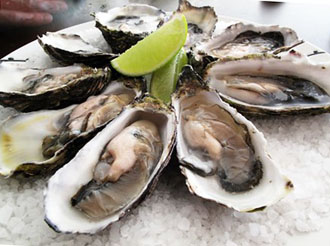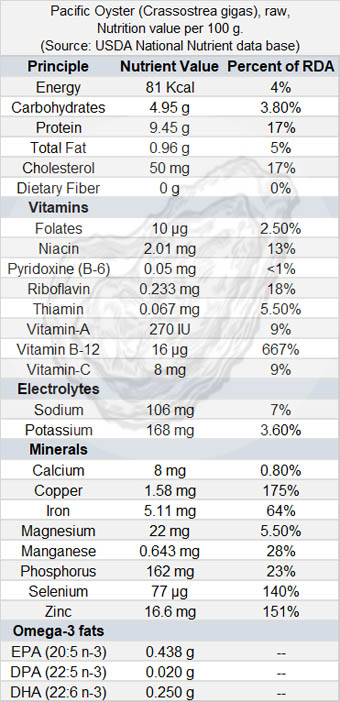Table of Contents
Buying
Pacific oysters come in various sizes, from small to large. Choose the size that best fits your preferences and recipe. Smaller oysters tend to be sweeter, while larger ones may have a more robust flavor.
Buy oysters from reputable suppliers or trusted fish markets to ensure quality and freshness. Oysters from certified or regulated sources are more likely to be safe to consume.
Look for oysters that are tightly closed or have a slightly open shell that closes when tapped. Avoid oysters with shells that are gaping wide open or broken.
The shells should be clean and free from cracks or chips. They should also feel heavy for their size, indicating they are full of meat and liquid.
Choose oysters with a fresh, briny smell of the sea. Avoid oysters that emit a strong, unpleasant odor, as it could indicate spoilage.
Storing
If buying from a fish market, ensure the oysters are properly stored on ice to maintain their freshness.
Once purchased, keep the oysters refrigerated and consume them within a day or two for the best taste and quality.
Preparation and serving methods
Pacific oysters are highly prized for their taste and have a briny and mildly sweet flavor with a firm texture.
They are incredibly versatile and can be prepared in various delicious ways; commonly eaten raw on the half shell but can also be grilled, fried, or used in various seafood dishes.
Here are some serving ideas:
 |
| Pacific oysters; shucked and served with lemon. Photo: gautsch |
-
Eating raw oysters can be a unique culinary experience. Ensure you purchase fresh, high-quality oysters from a reputable source. Before shucking, scrub the oysters under cold running water to remove any dirt or debris from the shell’s surface. You can accompany them with lemon wedges, cocktail sauce, mignonette sauce (a combination of vinegar, shallots, and pepper), or hot sauce according to your preference. Then, tilt the shell to allow the oyster to slide into your mouth. Some people chew the oyster, while others prefer to swallow it whole to experience the full flavor and texture.
-
Oysters Rockefeller is a New Orleans classic dish that involves baking oysters on the half shell topped with a mixture of spinach, herbs, breadcrumbs, and cheese.
-
Serve grilled oysters topped with garlic butter or herb butter.
-
In Japan, oysters are grilled (Yaki kaki-焼きカキ)in their shells over charcoal or open flame. Some variations include toppings such as butter, soy sauce, or miso paste.
-
Pacific oysters are breaded and deep-fried to make Kaki fry. They are served with tonkatsu sauce (a type of sweet and tangy sauce) and often accompanied by shredded cabbage.
-
Oyster Nabe (Kaki Nabe-牡蠣鍋): Oysters are added to hot pots or stews along with vegetables, tofu, and other ingredients. This dish is popular during the colder months.
-
Oysters Kilpatrick: This recipe combines oysters, bacon, and Worcestershire sauce for a smoky, flavorful dish.
-
Oysters with Mignonette Sauce: A simple yet elegant way to serve raw oysters is with a mignonette sauce made of shallots, vinegar, and pepper.
Safety profile
-
Oftentimes, eating raw Pacific oysters leads to vibrio bacteria (Vibrio vulnificus) infection that can cause gastrointestinal illness. Thorough cooking destroys these bacteria and makes them safe to consume.
-
Shellfish including Pacific oysters are a common food allergy that may affect around 1% of the population. Most of these allergic manifestations are mild to moderate in severity, ranging from hives (urticaria), tingling of the throat and mouth, swelling (angioedema), and gastrointestinal (vomiting, diarrhea).
-
Oysters hold methyl-mercury levels of 0.012 Parts Per Million (PPM). According to the U.S. FDA guidelines for expectant and breastfeeding mothers, it is categorized as the “best choice”, allowing it to consume 2-3 servings per week. (Medical disclaimer).
Also read ≻≻-
≺≺ Shrimp nutrition facts and health advantages.
≺≺ Lobster nutrition facts and health benefits.
≺≺ Surf clam nutrition facts and health benefits.
≺≺ Sea Scallops nutrition facts and health benefits.
≺≺ Back to Seafood from Pacific oyster nutrition facts and Health benefits.
Further reading (Links opens in new window):
-
NOAA-Fisheries –Crassostrea gigas.
-
Omega-3 Fatty Acids: An Essential Contribution.
-
U.S. Food & Drug Administration- Mercury Levels in Commercial Fish and Shellfish.


More Stories
United Healthcare’s ransomware attack shows why supply chains are under siege
Nutrition Tips For Ramadan | JM Nutrition
Probiotics for IBS | The Nutritionist Reviews